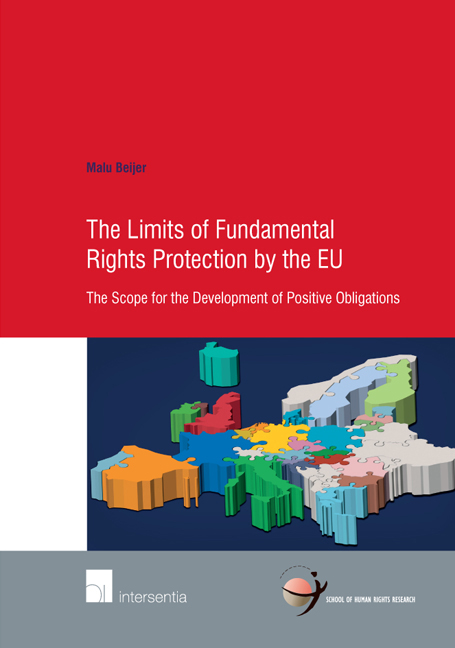 Limits of Fundamental Rights Protection by the EU
Limits of Fundamental Rights Protection by the EU Book contents
- Frontmatter
- About the Author
- Acknowledgements
- Contents
- Abbreviations
- Table of Cases
- Chapter 1 Introduction
- PART I THE CONCEPT OF POSITIVE OBLIGATIONS WITHIN THE CONTEXT OF THE EUROPEAN CONVENTION ON HUMAN RIGHTS
- PART II THE SCOPE FOR THE DEVELOPMENT OF POSITIVE OBLIGATIONS WITHIN THE CONTEXT OF EU LAW – AN ANALYSIS OF THE SPECIFIC PARAMETERS OF THE EU LEGAL ORDER AND THE EU SYSTEM OF FUNDAMENTAL RIGHTS PROTECTION
- PART III SYNTHESIS
- Chapter 11 The Development of Positive Obligations within the Context of EU Law: Overview and Evaluation of the Case-Law of the ECJ
- Chapter 12 Conclusions and Recommendations
- Bibliography
- Index
- Miscellaneous Endmatter
Chapter 11 - The Development of Positive Obligations within the Context of EU Law: Overview and Evaluation of the Case-Law of the ECJ
from PART III - SYNTHESIS
Published online by Cambridge University Press: 27 September 2018
- Frontmatter
- About the Author
- Acknowledgements
- Contents
- Abbreviations
- Table of Cases
- Chapter 1 Introduction
- PART I THE CONCEPT OF POSITIVE OBLIGATIONS WITHIN THE CONTEXT OF THE EUROPEAN CONVENTION ON HUMAN RIGHTS
- PART II THE SCOPE FOR THE DEVELOPMENT OF POSITIVE OBLIGATIONS WITHIN THE CONTEXT OF EU LAW – AN ANALYSIS OF THE SPECIFIC PARAMETERS OF THE EU LEGAL ORDER AND THE EU SYSTEM OF FUNDAMENTAL RIGHTS PROTECTION
- PART III SYNTHESIS
- Chapter 11 The Development of Positive Obligations within the Context of EU Law: Overview and Evaluation of the Case-Law of the ECJ
- Chapter 12 Conclusions and Recommendations
- Bibliography
- Index
- Miscellaneous Endmatter
Summary
INTRODUCTION
This chapter aims to portray and further discuss the examples of positive obligations that are present in the case-law of the ECJ. Some of these examples have already been addressed in the discussions in part II. Here, an overview is given of these and other examples of positive obligations so that some further insight can be given into the kinds of positive obligations that can be recognised within the context of EU law. In addition, a selection of five case are reviewed further and assessed in light of the conclusions reached in part II on the scope of, and the limits on, the development of positive obligations under EU law (see chapter 10). This analysis aims to establish whether (if at all) the development of positive obligations by the ECJ raises conflict with the specific principles of EU law.
The following section first briefly explains how the distinction between the concepts of positive and negative obligations can be made within the context of EU law and for what specific reasons it is relevant to make this distinction (section 11.2.). Aft er that, an overview of the different examples of positive obligations from the case-law of the ECJ is given (section 11.3.). On the basis of this overview, the types of positive obligations that can so far be recognised within the current case-law of the ECJ are identified (section 11.4.). A further examination is then made of some specific judgments of the ECJ to find out whether or not the ECJ has overstepped the specific limits of EU law, or whether the approach adopted is too restrictive (section 11.5.). The chapter is rounded up by a conclusion (section 11.6.).
THE DISTINCTION BETWEEN POSITIVE AND NEGATIVE OBLIGATIONS WITHIN THE CONTEXT OF EU LAW
The ECtHR also has contrasted the recognition of negative obligations which, more traditionally, follow from the protection of fundamental rights, with the recognition of positive obligations. The ECtHR in principle adopts a different approach when examining whether states have complied with their negative or positive fundamental rights obligations.
- Type
- Chapter
- Information
- Limits of Fundamental Rights Protection by the EUThe Scope for the Development of Positive Obligations, pp. 263 - 294Publisher: IntersentiaPrint publication year: 2017
